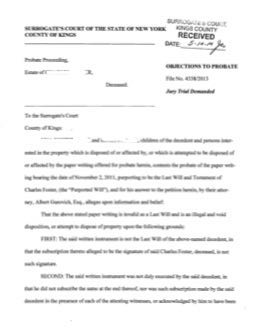Codicil Contests in New York
Contesting a codicil is a legal process undertaken to challenge the validity of a deceased person’s codicil. In New York, as in other states, there are specific grounds on which a codicil can be contested. We will discuss those grounds, as well as how they apply to prosecuting and defending a codicil contest.
Overview of the Grounds for a Codicil Contest
1. Formal Requirements Not Met: For a codicil to be valid, the people involved must follow the formal requirements specified in the statute, NY EPTL 3-2.1. New York is a state that has rigid formal requirements for executing codicils. Failure to adhere to every single one of these requirements can lead to a codicil failure and a successful codicil contest. The formal requirement that fails the most? The codicil-maker not saying to the witnesses that the document is their codicil.
2. Forgery: If the codicil is a forgery, in whole or in part, then it fails and the codicil contest is a success. The most common forgery methods are to claim that a document is a person’s codicil when that person never singed the document, or replacing pages in a codicil.
3. Undue Influence: This occurs when a trusted individual takes advantage of a person and manipulates them into making a codicil. Proving undue influence is not easy, because it often occurs behind closed doors. For that reason, the contestant will have to rely on circumstantial evidence.
4. Lack of Mental Capacity: To contest a codicil based on this ground, you have to prove that the deceased did not understand the nature of their assets, their relatives, and friends, or what was in the codicil at the time of its execution. Medical records showing conditions such as dementia disorders or mental illness are used as evidence of lack of mental capacity.
5. Fraud: Contesting a codicil based on fraud involves showing that the beneficiaries knowingly misled the deceased into signing the codicil, either by misrepresenting the contents of the codicil or by providing false information about outside circumstances.
6. Duress: To contest a codicil based on duress, you have to prove that someone forced the decedent to make a codicil.
This guide will delve into each of these grounds in detail and explore the various challenges faced when contesting a codicil in New York, shedding light on the legal intricacies involved in this process. While this guide provides some detailed explanations on using the above grounds for contesting a codicil, it is important to note that the task of proving them in court is a complex and subtle undertaking best handled by experienced estate litigation attorneys.
Formal Requirements Not Met

Do you remember when we were able to fight traffic tickets because of mistakes in writing them or the way they were set up? We’d have our lawyer dismiss the ticket on technical grounds. Well, that’s still sometimes possible in codicil contests.
For a codicil to be valid, the people involved in the codicil execution need to follow formal requirements for executing a codicil. And New York has some of the most rigid codicil execution requirements in the country. If execution formalities were not correctly followed, the codicil could fail, and we could successfully contest that codicil, leading to the codicil being overturned and invalidated by the Surrogate’s Court. That is why we advise that when a person makes a codicil, they do so in the presence of an estate attorney. In making a codicil, as well as in contesting one, you will need to be familiar with the formal requirements of codicil execution.
A list of formal requirements for a codicil
In order for a document to be accepted by the court as a valid codicil, it needs to meet the formal execution requirements of NY EPTL 3-2.1, which are:
- The person making the codicil has to sign the codicil (or direct someone else to sign their codicil in their presence)
- The person making the codicil has to sign at the end of the codicil, not in the middle of it.
- There need to be two witnesses to the codicil
- The person making the codicil has to sign the codicil in the presence of each witness
- The person making the codicil must communicate to the witnesses that they are witnessing a codicil
- everyone has to complete the entire ceremony within 30 days of the codicil signer’s signature
The people involved have to follow New York execution formalities. Problems can creep up, such as when the potential codicil-maker did not declare the document to be their codicil, or the witnesses are not there or not fully there. We can use those “hiccups” to litigate a successful codicil challenge in New York.
A codicil that was not supervised by an attorney is easier to contest
When a person makes a codicil without an attorney present, they are playing Russian Roulette with the validity of their codicil. It is easy to figure out how to challenge a DIY codicil. No estate attorney would possibly testify to support such a codicil, because no attorney was present when the codicil was claimed to have been executed. Here are the common scenarios where this problem with codicils occurs:
- A codicil printed out from the internet
- A store-bought codicil form
- A codicil provided by one of the beneficiaries
- A self-made codicil
- A codicil from an attorney but does not have the attorney supervise the execution of the codicil
Where the codicil was signed with an attorney present, that attorney would typically testify that he made the codicil at the request of the person whose name is on it and the witnesses will testify that they saw the person sign the codicil and declare it to be a codicil to their will. After that, the codicil contest will focus on mental capacity and undue influence.Where the codicil was signed without an attorney, there is no attorney to testify that the codicil was made correctly, so the codicil contest codicil also deal with possible issues of the codicil not made correctly and not signed correctly.
Where the codicil has problems with the attorney or witnesses, the codicil contest will also focus on forgery, which we discuss next. The problems with attorney or witnesses can be as follows:
- they have a connection to the person benefitting from the codicil
- are no longer living, or
- are sketchy or suspicious (you’ll know if when you see it)
There is little place left for ceremony in the modern world. A codicil execution is one of the few exceptions, and it needs to be followed precisely in order for a codicil to be valid.
Lack of execution formalities is a powerful codicil contest ground, and one that results in the most overturned codicils, at least in our experience.
Forgery

If somebody forged a part of the codicil and we can prove the forgery, then we can have the Surrogate’s Court declare the codicil to be invalid. When contesting a codicil, you will likely need to hire an expert familiar with the different forgery methods. The expert will examine the suspect codicil, prepare a report and testify in court.
How people forge codicils
A forgery can either be of the signature or the document. Signature forgery is copying the signature, tracing it, or pasting it from a different document. Forgery of the document is replacing the pages or changing the text.
Working with a handwriting expert
We win forgery-based codicil contests by bringing a handwriting expert to present evidence of other handwriting samples of the deceased. The handwriting expert compares the handwriting on the codicil and testifies that it’s not a close enough match. The handwriting expert would also determine if the handwriting on the codicil belongs to someone else, such as the person benefiting from the codicil.
A forgery trial can easily become a battle of the experts. Getting the most presentable and authoritative expert can make all the difference.
Undue influence

In codicil contest parlance, pressure to make a codicil is called duress and manipulation of the person who died is called undue influence.
Proving undue influence
To prove undue influence, you would have to show that a trusted person took advantage of the person who died and manipulated him into making the codicil.
While undue influence most often is not the subject of direct proof, it may be proved by circumstantial evidence. It can be shown by all the facts and circumstances surrounding the person who died, the nature of the codicil, his family relations, the condition of his health and mind, his dependency upon and subjection to the control of the person supposed to have wielded the influences, the opportunity and disposition of the person to wield it, and the acts and declarations of such person.
Proving a confidential relationship is a plus
This confidential relationship power-up does not work well when the beneficiary of the codicil is a relative. It only works well when the person benefitting from the codicil is a caretaker or a different professional helping the person who died.
Manipulation
Psychopaths with narcissistic personalities are good at using manipulative tactics. Their favored ways of manipulating vulnerable seniors are
- Triangulating – encouraging the victim’s negative thoughts about a close person and
- Gaslighting – providing a false view of reality to the victim
Opportunistic charlatans can use undue influence to manipulate trusting older adults into leaving them an unfair share of the inheritance at the expense of the vulnerable person’s family and true wishes. If you believe that someone took advantage of your loved one, you may be able to overturn their so-called “codicil.” This is done with the help of a lawyer through a codicil contest in New York Surrogate’s Court. But at the same time, if a person who signed the codicil wanted to set up their codicil a certain way, was not defrauded and had full mental capacity, then that’s their business. In New York, you can disinherit your relatives if you wish to do so.
Case Study from Our Practice: Contesting a Codicil Due to Undue Influence
- Background: Our client approached us with concerns that her late brother’s codicil had been manipulated by her brother’s neighbor.
- Challenge: Proving undue influence and lack of mental capacity.
- Action: Our team gathered evidence, including the fact that the neighbor had a prior criminal conviction for financial fraud, that the brother had a history of mental illness, and the money came from family. The attorney who drafted the codicil admitted in examination under oath that the neighbor was an acquaintance of the attorney’s husband’s and the neighbor arranged the appointment and drove the brother to the attorney, whose office was in a different borough than where the brother resided. It also became apparent that the neighbor was exerting a tremendous amount of influence over the brother and was essentially in charge of his finances.
- Result: The case settled with the sister getting a substantial amount.
Lack of Mental Capacity

To prove a codicil contest based on lack of mental capacity, you would have to prove that the person who died was so out of it that they did not know what they were doing. To contest a codicil based on this ground, we would typically have to show that the person had some kind of serious problem with their brain function which prevented them from understanding what is going on with the codicil.
Legally, to show mental incapacity, we need to prove that the person who died did not understand one or more of the following:
- what they own
- who their relatives and friends are
- what is in their codicil.
To show what was wrong with the person who died that they did not have the mental capacity, we would typically have to prove one or more of the things below.
Dementia Disorders
A codicil contest based on a lack of mental capacity has a higher chance of success when the person who died suffered from a dementia disorder.
- Alzheimer’s – this is the biggest cause of dementia. Early-onset can start as early as the age of 40 or 50, and progresses with age. It destroys cognitive functioning and may cause them to lose the capacity to make a codicil.
- Vascular Dementia – often caused by a stroke, results from obstruction of blood flow to the brain
- Parkinson’s Decease – degeneration of nerves in the brain
- Frontotemporal Dementia – deterioration and shrinkage in front and side areas of the brain
- Dementia due to head injuries
- Dementia due to HIV or medications
Changes in memory and behavior in older adults usually point to dementia. The gradual cognitive decline caused by a degenerative condition eventually results in the loss of mental capacity required to make a codicil. The more dementia progresses, the harder it becomes to make decisions. Therefore, the later the stage of dementia, the more likely it is for the codicil contest to succeed.
Mental Illness
Mental illness in and of itself does not mean that the decedent lacks capacity. For a codicil contest to work, you will need to prove that mental illness played a role in the making of the codicil. Some examples of mental illness that can impact the capacity to make a codicil are:
- Depression – The person who signed the codicil feels hopeless and passive and does not care what happens to their estate. The elderly often suffer from depression towards the ends of their lives. Family conflicts relating to inheritance only exacerbate their depression.
- Paranoia – The pervasive distrust of people with paranoia can make it easier to manipulate and “triangulate” them into excluding some people from their codicil.
- Bipolar – People suffering from bipolar disorder experience mood swings from extreme highs (mania) to extreme lows (depression). Caretakers, relatives and acquaintances can exploit those mood swings to get a person to favor them in their codicil.
- Schizophrenia – People with schizophrenia experience delusions and distorted reality. Caretakers, relatives and acquaintances can take advantage of those mental deficiencies in order to manipulate the person into making a codicil bequest.
Personality Disorders
Personality disorders are not indicative of a lack of capacity. But they can still make some difference in a New York codicil contest. For example, if the person who died had a “Cluster C” Dependent Personality Disorder, then they can be vulnerable to undue influence. We look to symptoms such as
- excessive dependence on others
- submissive behavior
- fear to have to provide self-care
- difficulty disagreeing with others and
- tolerance of poor or abusive treatment
Physical Factors
Weak physical state – We challenge codicils of decedents whose weak physical state adversely influenced their mental capacity.
Mind-altering pharmaceuticals – If the person who died was taking mind-altering pharmaceuticals during the codicil execution, then his capacity to execute a codicil could be diminished. Sedatives, antipsychotics, and pain medications can push a mental state over the edge of capacity.
Drifting in and out and lucid moments – Older people may drift in and out, sometimes lucid and sometimes not. If you are contesting the codicil, you will need to show that the decedent was not having any lucid moment. An attorney who made the codicil may testify that the person who died had a lucid moment when he executed the codicil.
Some codicil contest lawyers and medical professionals hold the view that the lucid moment concept is out of date with the modern understanding of mental capacity. Their view is once the person who died lost mental capacity, he does not get it back. However, at this time, our courts still consider lucid moments, so this is an important factor to consider in New York codicil challenges.
Finding circumstantial evidence
In contesting a codicil, we don’t have to prove that the decedent lacked capacity on the exact day of the codicil signing. Instead, we can use circumstantial evidence to show that the decedent lacked capacity during at that time. But the time period in question is limited to around the date of the purported codicil.
Obtaining medical records
When contesting a codicil, the most effective strategy for challenging the decedent’s mental capacity is to obtain medical records from the medical providers. You can then go through those medical records and see if any notes point to incapacity.
Looking up medications
It’s good to check for a list of Alzheimer’s or dementia medications, sedatives and antipsychotics. You can find a list online.
Looking at mental capacity tests
Different forensic and analytical tests will be used to asses the mental capacity of the person who died. The decedent might have been administered a Mini-Mental Exam or the Clock Test while they were still alive. After their death, we can no longer give them a test. But we can still use models of mental capacity such as PARADISE – 2 to argue that the decedent had impaired brain function at the time of the events in question.
Fraud

Fraud in factum
One type of fraud is misleading the decedent about the codicil itself. Beneficiaries slip a codicil under a guise of a different document or mischaracterize what is in the codicil and have the person who died unknowingly sign it.
Fraud in the inducement
Another type of fraud is misleading the person who died about circumstances outside of the codicil. They can be fed misinformation about friends and relatives or other things in their lives.
Duress
To prove duress, you would have to show force and coercion. Duress is the use of force, false imprisonment, or threats to compel the person who died to make the codicil a certain way. Duress usually comes hand in hand with other elder abuse. The abuser uses violence or the threat of violence to get a person who died to change his or her codicil in the abuser’s favor.
Revocation

A person who signed the codicil can revoke a codicil by destroying it or crossing out the signature.
If no one can find the codicil, we presume that the person who signed the codicil revoked the codicil, unless someone proves otherwise.
A person who signed the codicil can revoke a codicil by making a new one. The latest codicil always controls, unless overturned, in which case we revert to the will orcodicil before that.
Revocation is a good ground to consider when there are multiple documents that are purported to be wills or codicils of the decedent.
A Breakdown of the Reasons Codicils Get Contested
The chart below provides a visual breakdown of the grounds that we focus on in questioning a codicil’s legitimacy.
Strategies For Contesting a Codicil
Here are some effective strategies for contesting a codicil that can significantly enhance your likelihood of overturning a codicil or getting a settlement.
Weighing the costs and benefits
Before initiating codicil contest, it may help to weigh the following factors:
- Strength of Evidence: How strong and convincing is your evidence?
- Asset Value: What’s the estimated worth of the stolen inheritance?
- Time and Cost: Evaluate the time you’ll spend and the legal fees and expenses you’ll incur.
By assessing these factors, you can make a well-informed decision on whether it’s worthwhile to pursue the recovery of the stolen inheritance.
To know more about the costs of a codicil contest, you can click here. The cost of your codicil contest can range between four to five figures and codicil depend on the stage in which your claim is concluded: out of court, during the initial probe, discovery, or after trial.
Filing the Objections
To contest a codicil, you will need to have your attorney file objections to probate of the codicil. Objections is a document that lists all of the potential problems with the codicil and asks the court to reject the codicil.
Your attorney will file the objections with the court. This filing will set your codicil contest in motion.
As an example, here is a front page of a set of objections we’ve filed for one of our clients:

Pleading all possible grounds
When contesting a codicil, we often plead every possible ground for a codicil contest, hoping that we find one that sticks. If the decedent was not well enough to make a codicil, then he was probably vulnerable to being misinformed or pressured to make a codicil.
It is true that in some codicil contest situations, an opportunity for a win can be spotted early on in the case. We can then proceed with a laser-sharp focus on a single issue. However, the most common strategy is still to plead every possible Codicil contest ground and see which one of them turns out to be more successful.
Trying to settle the case
We try to settle codicil contests before trial. If a settlement is not possible, then the sides will proceed to exchange more documents and information, and ultimately progress to trial. The judge or the jury decide whether the codicil is valid.
Looking at the possible outcomes
While the codicil is being contested, the executor is not permitted to distribute the estate until after the trial. The court can find that the codicil is valid. If the court finds the codicil to be invalid, the court codicil do one or more of the following:
- Not admit the codicil
- Admit only a portion of the codicil
- Admit an earlier codicil in its place
- Not admit any of the codicils, and distribute assets among the decedent’s relatives as if there was no codicil.
Not missing the codicil contest deadline
| Deadline Alert: | Once the court approves the codicil for probate, it will be too late to contest it. Act before the first hearing in the case. |
|---|
Getting a lawyer
We have never seen a person fight a codicil contest without a lawyer. You should never go into a codicil contest without trial counsel. Even though you now have all this information, you will still be at a great disadvantage because you don’t have the experience in contesting a codicil.
Strategies for Defending a Codicil From a Contest
Here are some effective strategies for defending a codicil that can significantly enhance your likelihood of getting the codicil probated or minimizing the settlement amount.
Listen to your attorney! Estate attorneys have the expertise and experience to guide you through the defense process. Their advice is based on legal knowledge and past experiences, so it’s crucial to heed their recommendations.
Ask you attorney how to handle the codicil. An attorney specializing in estate law will have the expertise to advise on the proper care, storage, and presentation of the codicil. They can provide guidance on legal protocols, potential pitfalls to avoid, and best practices to ensure the codicil’s integrity remains unquestionable. Entrusting the codicil’s handling to legal counsel can also prevent inadvertent mistakes that could compromise its validity in court.
Gather your evidence. Collecting all relevant evidence, such as medical records or correspondence, can help demonstrate the testator’s intentions and mental capacity at the time the codicil was drafted.
Do not tamper with the codicil. Any alterations or signs of tampering can cast doubt on the codicil’s validity and may be used as grounds to contest it.
Do not tamper with the witnesses. Witnesses play a crucial role in affirming the testator’s state of mind and the codicil’s legitimacy. Any attempt to influence or tamper with their testimonies can jeopardize the codicil’s defense.
Do not tamper with any evidence. Preserving the integrity of all evidence related to the codicil is paramount. Any alterations, deletions, or manipulations can cast doubt on its authenticity and your intentions. Tampering with evidence can not only weaken your defense but may also lead to legal penalties or sanctions. It’s essential to maintain the original state of all documents, communications, and other relevant materials to ensure a fair and transparent legal process.
Do not remove staples. Removing or altering staples can indicate that pages of the codicil might have been changed or replaced, casting doubt on its authenticity.
Follow all deadlines. Legal proceedings have strict timelines. Missing a deadline can result in penalties, delays, or unfavorable rulings.
Engage expert witnesses if needed. Experts, such as geriatric psychiatrists or handwriting analysts, can provide specialized testimonies that strengthen the codicil’s defense, especially concerning the testator’s mental capacity or the codicil’s authenticity.
Secure witness testimony. Witnesses to the codicil’s signing can attest to the testator’s state of mind and the circumstances surrounding the codicil’s execution. Their testimonies can be pivotal in confirming the codicil’s legitimacy. But do not tamper with the witnesses.
Codicil contest FAQs
What does it mean to contest a codicil?
Contesting a codicil means challenging its validity in court. If someone believes the codicil doesn’t reflect the true intentions of the deceased or was created under suspicious circumstances, they may contest it.
Who can contest a codicil?
Any person affected by the codicil, such as beneficiaries or potential heirs, can challenge the codicil after it’s submitted to the court for approval.
What is undue influence?
Undue influence occurs when the testator is manipulated or pressured into creating a codicil that benefits someone else, often at the expense of their true wishes.
How is fraud different from undue influence?
Fraud involves deception, such as lying to the testator about certain facts, which influences how they distribute their property in the codicil.
What happens if a codicil contest is successful?
If a court determines that all or parts of the codicil are invalid, the property may be divided as if there were no codicil at all, following New York’s laws of intestacy.
How can I ensure my codicil is not contested after my death?
It’s crucial to seek legal counsel and follow all legal procedures when creating a codicil.
What is the difference between duress and undue influence?
Duress involves extreme pressure or threats to force someone to create a codicil in a certain way. Undue influence is more subtle and involves manipulating someone’s decisions without direct threats.
How long do I have to contest a codicil after someone’s death?
The timeframe can vary, but it’s essential to act promptly. Consulting with a legal professional can provide specific guidance on time limits.
Do I need a lawyer for a codicil contest?
While it’s theoretically possible to fight a codicil contest without legal representation, doing so carries a high risk of losing. Hiring a lawyer can increase the chances of success and ensure you navigate the legal system effectively.
What is the “sound mind” requirement for creating a codicil?
A person is considered of “sound mind” if they understand the nature and extent of their property, know the natural beneficiaries of their estate, and understand the disposition they are making through the codicil.
Can I contest a codicil if I’m not mentioned in it?
Yes, especially if you are a direct heir or believe you were intentionally or mistakenly excluded. The court will consider your relationship to the deceased and the circumstances surrounding the codicil’s creation.
What evidence is needed to prove undue influence or fraud?
Evidence can include witness testimonies, written communication, suspicious changes in the codicil shortly before the testator’s death, or evidence showing the testator was isolated from family and friends.
How long does a codicil contest typically take in court?
The duration can vary based on the complexity of the case, the evidence presented, and the court’s schedule. It can range from a few months to several years.
What are the costs associated with contesting a codicil?
Costs can include court fees, attorney fees, expert witness fees, and other related expenses. It’s essential to discuss potential costs with your attorney before proceeding.
Can a no-contest clause in a codicil prevent beneficiaries from challenging it?
A no-contest clause is designed to discourage beneficiaries from contesting the codicil by stating they will lose their inheritance if they do so. However, the beneficiary can conduct a preliminary probe without triggering the no-contest clause.
What happens if multiple versions of a codicil exist?
The most recent validly executed codicil is typically considered the final expression of the testator’s wishes. However, if there’s evidence of fraud or undue influence in the latest version, an earlier codicil might be upheld, or sometimes no codicil at all.
Can I contest a codicil if I believe the executor is acting dishonestly?
If you believe the executor is not fulfilling their duties or is acting in their own interests, you can petition the court to have them removed and replaced. But this is not a ground for a codicil contest per se.
What is the difference between probate and a codicil contest?
Probate is the legal process of validating a codicil and distributing assets. A codicil contest is a challenge to the validity of the codicil itself.
If a codicil is declared invalid, what happens to the assets?
If there’s no other valid codicil, the assets will be distributed according to New York’s intestacy laws, which dictate how assets are divided among surviving relatives.
On what grounds can a codicil be contested?
The grounds for a codicil contest are:
- Lack of execution
- Forgery
- Undue influence
- Lack of capacity
- Fraud
- Duress
Client Testimonials
Mrs. Michele Hines Diaconescu.
Russell Kivatisky, Ph.D.
If you are involved in a codicil contest, we at the Law Offices of Albert Goodwin are here for you. We have offices in New York City, Brooklyn, NY and Queens, NY. You can contact us by calling 212-233-1233 or sending us an email at [email protected].













